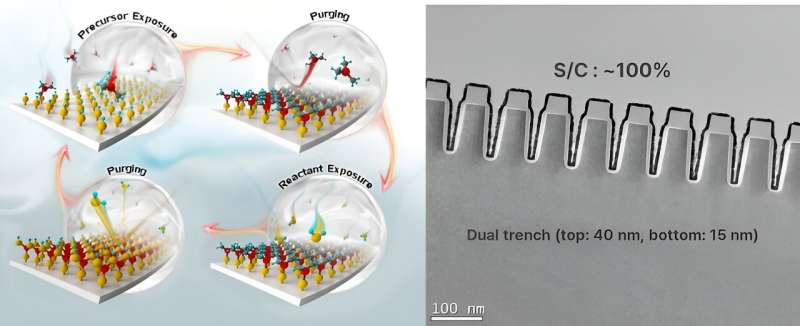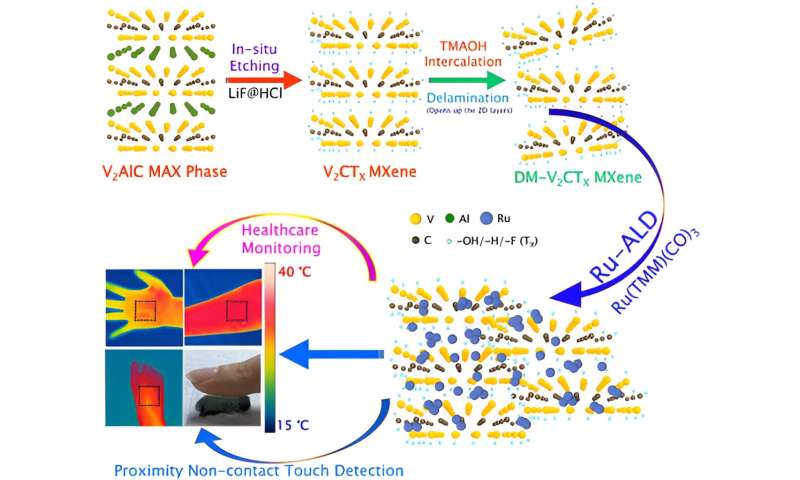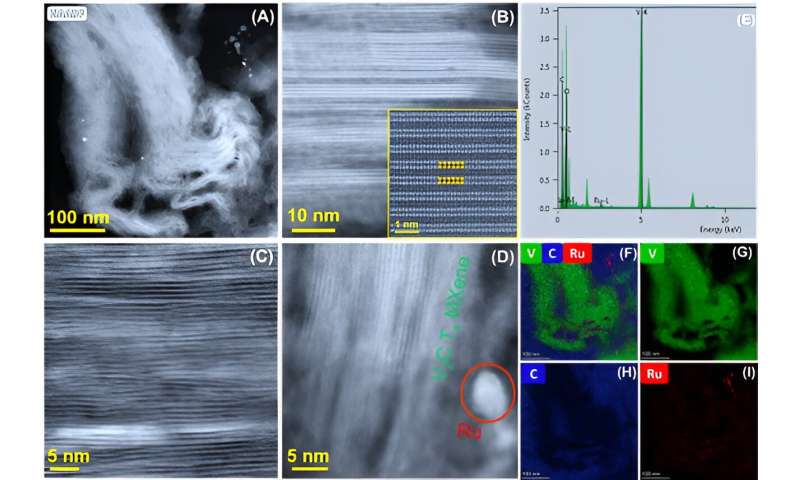This article has been reviewed according to Science X's editorial process and policies. Editors have highlighted the following attributes while ensuring the content's credibility:
fact-checked
peer-reviewed publication
trusted source
proofread
A novel avenue for engineering 2D MXene family via precious metals atomic layer deposition techniques

A team of researchers, led by Professor Soo-Hyun Kim in the Graduate School of Semiconductors Materials and Devices Engineering and the Department of Materials Science and Engineering at UNIST has made significant progress in precisely controlling precious metals (Ru, Ir, Pt, Pd) incorporation by atomic layer deposition (ALD).
In this study, published in Advanced Science, the team successfully developed unique and unexplored two-dimensional (2D) nanomaterials V-MXene for the very first time coupled with precious metal ruthenium (Ru) through the ALD process. This breakthrough holds immense promise for various applications, both contact and non-contact mode of real-time temperature sensing at the human-machine interface.
The integration of Ru-engineered V-MXene through ALD has demonstrated a remarkable 300% enhancement in device sensing performance and durability, surpassing the capabilities of pristine V-MXene. This advancement not only paves the way towards the creation multifunctional, cutting-edge personal health care devices, but also holds great promises for the progression of clean energy conversion and storage technologies.
Moreover, the utilization of the industrially scalable ALD technique used in this research enables precise engineering of MXene surfaces with precious metals, thereby opening up new possibilities for future applications.
-

Figure 2. As-synthesized bulk quantity delaminated V2CTX MXene (DM-V2CTX) to develop Ru-ALD Engineered DM-V2CTX (Ru@DM-V2CTX) for real-time skin temperature sensing, noncontact touch, proximity sensing, and breathing monitoring. Credit: Advanced Science (2023). DOI: 10.1002/advs.202206355 -

Figure 3. Ru-ALD engineered DM-V2CTX MXene microstructure and elemental mapping. (A) HAADF STEM showing the presence of layered DM-V2CTX MXene structure and the distribution of Ru atoms/clusters, (B, C) HR-STEM of the well-defined layered structure of DM-V2CTX MXene throughout the sample and inset (B) confirms the opening of V2CTX MXene layers after the removal of Al-layers, (D) HR-STEM of both layered DM-V2CTX MXene and Ru lattices, (E) Super-X EDS elemental spectra confirming the elements V, C, Ru, and (F–I) their corresponding elemental mapping images. The atoms in Fig. 2B inset are shown with the same colors as illustrated in Figure 1 after the etching and delamination process. Credit: Advanced Science (2023). DOI: 10.1002/advs.202206355
"We are thrilled by the potential of this breakthrough," said Professor Kim. "The precision-enabled integration of precious metals opens up a whole new world of possibilities in the development of versatile, next-generation, and safe personal health care devices, as well as clean energy conversion and storage systems, with the potential to substantially impact people's lives."
Dr. Debananda Mohapatra, an Associate Research Professor in the Graduate School of Semiconductors Materials and Devices Engineering at UNIST, emphasized the ease and versatility of engineering MXene surfaces with precious metals, using industrially favored ALD techniques. He also highlighted the potential for real-time applications in wearable health care devices and clean energy fields. He said, "This successful work marks the beginning of a thriving research field of focused on advancing 2D nanomaterials engineering and applications empowered by ALD."
The research team further highlighted the vast potential for exploring the less investigated non-Ti-MXenes, such as Mo, V, and Nb-based MXenes, for surface-internal structure engineering using selective precious metals (Ru, Ir, Pt, Pd) ALD processes.
By incorporating single atoms or atomic clusters of precious metals (Ru, Ir, Pt, and Pd), the resulting surface activity and the sensitivity/energy performance per atom can be significantly enhanced. This approach minimizes the use of these scarce and expensive precious metals.
More information: Debananda Mohapatra et al, Process Controlled Ruthenium on 2D Engineered V‐MXene via Atomic Layer Deposition for Human Healthcare Monitoring, Advanced Science (2023). DOI: 10.1002/advs.202206355
Journal information: Advanced Science





















